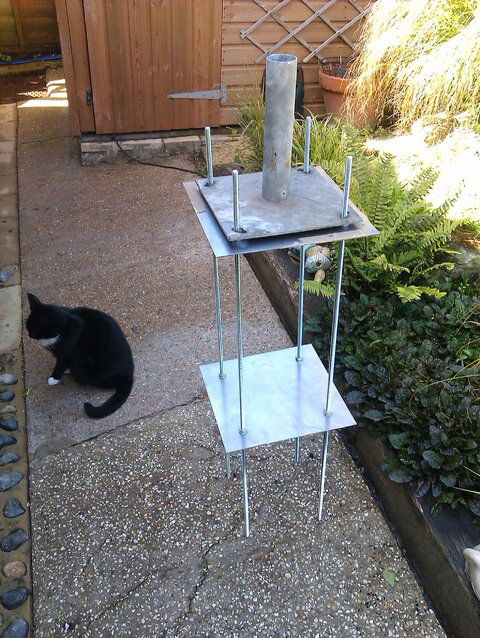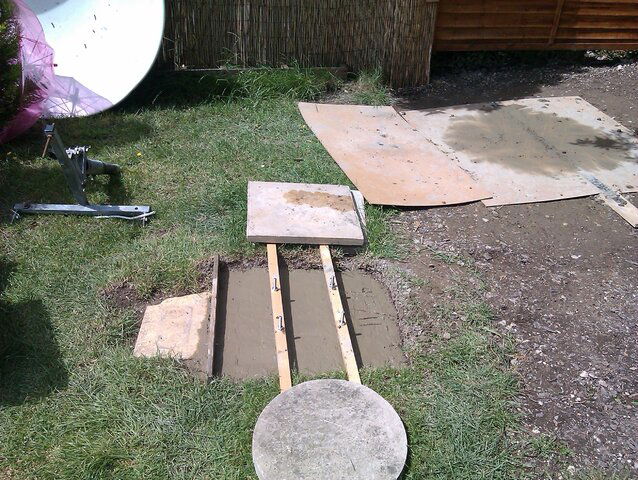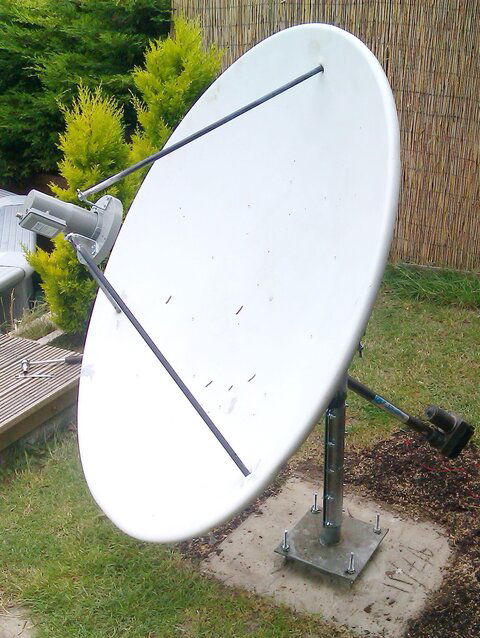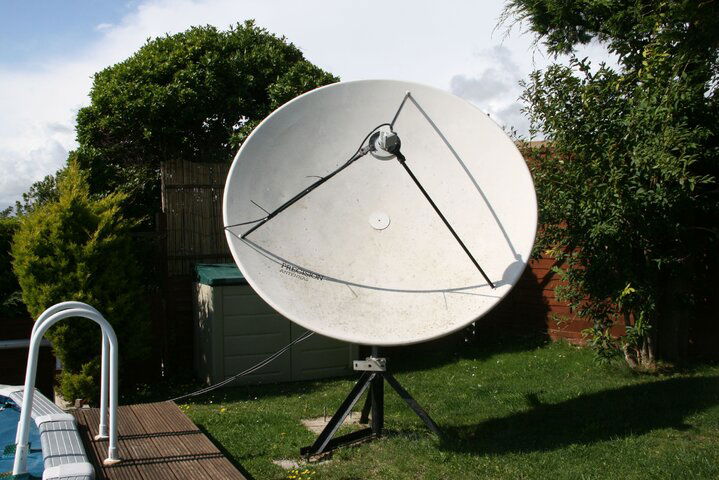10ft. Mesh ChannelMaster
- Thread starter O'Doyle
- Start date
- Latest activity Latest activity:
- Replies 40
- Views 10K
You are using an out of date browser. It may not display this or other websites correctly.
You should upgrade or use an alternative browser.
You should upgrade or use an alternative browser.
- Status
- Please reply by conversation.
I bought a couple of these really low priced c-band lnbs for backups, and it surprised me how well they worked: http://www.ebay.com/itm/NEW-C-BAND-...ellite_LNB_Downconverters&hash=item1c05eeddf7
or a 4DTV to move the dish and change polarity then you can piggy-back the FTA onto the 4DTV.You will need something like the Titanium ASC-1 so you can change polarity.
ok kool...how does the one I have compare to the Titanium C-PLL that I read you all like really well?
There are advantages and disadvantages to both.
Your Corotor with C and KU LNBs offers the best solution if you wish to receive both C and KU bands on the single dish. The C and KU LNBs may be independently upgraded to very high quality and stable models such as a Phase Lock Loop, but these upgrades can be very expensive. The blue servo motor on the back of the feedhorn allows the skew offset to be adjusted for each satellite to optimize for best reception. The servo motor will require a controller to position the probe for each polarity change. This is where the ASC1 controller comes in. It connects to the DVB satellite receiver and automatically moves the dish to the correct satellite and sets the polarity and offset skew when the receiver's channel or transponder is changed. A legacy 4DTV or analog IRD may also be used, but they are not automatic. The satellite selection and polarity/skew offset must be manually selected and coordinated with the DVB receiver for each satellite, transponder or channel change.
The Titanium Satellite C1PLL is a phase lock loop LNBF which provides maximum stability for receiving difficult signals. It automatically changes polarity when the DVB receiver selects a transponder or changes channels. It is the least expensive option to upgrade to PLL technology. The polarity/skew offset angle is fixed and universally set. It cannot be adjusted for each satellite or polarity and you do loose the ability to fine-tune to attenuate interference or optimize signal quality. An actuator controller is still required to position the dish. You can use a less expensive G/VBox type or a legacy 4DTV or analog IRD, but the IRD would not be automatic and must be manually selected and coordinated with the DVB receiver for each satellite.
Your Corotor with C and KU LNBs offers the best solution if you wish to receive both C and KU bands on the single dish. The C and KU LNBs may be independently upgraded to very high quality and stable models such as a Phase Lock Loop, but these upgrades can be very expensive. The blue servo motor on the back of the feedhorn allows the skew offset to be adjusted for each satellite to optimize for best reception. The servo motor will require a controller to position the probe for each polarity change. This is where the ASC1 controller comes in. It connects to the DVB satellite receiver and automatically moves the dish to the correct satellite and sets the polarity and offset skew when the receiver's channel or transponder is changed. A legacy 4DTV or analog IRD may also be used, but they are not automatic. The satellite selection and polarity/skew offset must be manually selected and coordinated with the DVB receiver for each satellite, transponder or channel change.
The Titanium Satellite C1PLL is a phase lock loop LNBF which provides maximum stability for receiving difficult signals. It automatically changes polarity when the DVB receiver selects a transponder or changes channels. It is the least expensive option to upgrade to PLL technology. The polarity/skew offset angle is fixed and universally set. It cannot be adjusted for each satellite or polarity and you do loose the ability to fine-tune to attenuate interference or optimize signal quality. An actuator controller is still required to position the dish. You can use a less expensive G/VBox type or a legacy 4DTV or analog IRD, but the IRD would not be automatic and must be manually selected and coordinated with the DVB receiver for each satellite.
Thanks Titanium! So I could use the Amiko Mini HD SE receiver I bought and then get the ASC1 controller and use my existing LNB set up (if it still works) and be ok? The actuator that was on the dish is old and not looking functional, not sure what brand it is or length of it, what recommendations would you have for a newer actuator that would work with what I have? would a 24 inch actuator be acceptable for the size dish I have?
Thanks Titanium! So I could use the Amiko Mini HD SE receiver I bought and then get the ASC1 controller and use my existing LNB set up (if it still works) and be ok? The actuator that was on the dish is old and not looking functional, not sure what brand it is or length of it, what recommendations would you have for a newer actuator that would work with what I have? would a 24 inch actuator be acceptable for the size dish I have?
Yes, exactly what you could do to use the Corotor!
Legacy actuators usually don't fail too easy and clean-up real nice with some penetrating oil and steel wool. Once it is clean and shiny, coat with some quality lube. You might need to take the housing apart, clean the gears and lube. Check out the motor for rust, blow it out and rotate by hand before applying power. A quality 24" actuator should do fine on the lightweight mesh. If you buy, go with a quality motor that will last for years. Check out the Venture brand (Made in America)!
I think a lot of it is personal preference. If you are going to lock your dish down on a single satellite, using only C-band, and use a modern receiver or PC tuner card, to me it makes far more sense to simply upgrade the feedhorn/LNB to a newer integrated model that uses voltage to switch the polarity, similar to the way that small dish LNB's are switched by voltage. The reason is that switching is instantaneous and is unaffected by extreme cold or hot weather, plus it is much less expensive to go that route than to buy a controller. That is what I did; I have several of the old mechanical switched feedhorn/LNB combos in a box somewhere (including a C/Ku combo unit that's probably the same as what you have) and I personally would not even think of using one of them again.
But if I were going to receive both C and Ku using the same dish, or if I were going to try to scan the entire arc using a single dish, I might think differently. Well, probably not in my case, I just find the newer LNB's so much easier to set up, and to me they do a much better job. Also, I like the fact that you can get dual C-band LNB's so you can run multiple tuner inputs accessing the same dish, particularly on satellites that have a lot of good C-band signals. But I can understand that those older units do seem to work better for C/Ku combos, and also have the advantage that the skew can be adjusted in case you are tuning a satellite where the skew is slightly off. There also the upside that you can peak the skew from inside the house rather than while standing on a ladder in front of the dish, but if you are going to lock a dish down on a single satellite, chances are you'll never have to peak the skew again after the initial installation.
I will admit those older feedhorns were much better built mechanically than some of the newer stuff, but still, to me it just seems like the newer polarity-switched integrated feedhorn/LNB's yield a bit higher signal strength. YMMV. Also with regard to the newer ones, there is some real junk being sold on eBay, so be careful where you buy. I'm not saying you need the most expensive model out there, although in some cases there is a reason for a slightly higher price, but there is a lot of bottom end junk that is much more likely to die on you when the temperature gets too cold or too hot, or give you other weird problems.
But if I were going to receive both C and Ku using the same dish, or if I were going to try to scan the entire arc using a single dish, I might think differently. Well, probably not in my case, I just find the newer LNB's so much easier to set up, and to me they do a much better job. Also, I like the fact that you can get dual C-band LNB's so you can run multiple tuner inputs accessing the same dish, particularly on satellites that have a lot of good C-band signals. But I can understand that those older units do seem to work better for C/Ku combos, and also have the advantage that the skew can be adjusted in case you are tuning a satellite where the skew is slightly off. There also the upside that you can peak the skew from inside the house rather than while standing on a ladder in front of the dish, but if you are going to lock a dish down on a single satellite, chances are you'll never have to peak the skew again after the initial installation.
I will admit those older feedhorns were much better built mechanically than some of the newer stuff, but still, to me it just seems like the newer polarity-switched integrated feedhorn/LNB's yield a bit higher signal strength. YMMV. Also with regard to the newer ones, there is some real junk being sold on eBay, so be careful where you buy. I'm not saying you need the most expensive model out there, although in some cases there is a reason for a slightly higher price, but there is a lot of bottom end junk that is much more likely to die on you when the temperature gets too cold or too hot, or give you other weird problems.
Thanks Acient appreciate the advice! I will probably try the LNB that came with the dish to see what I pick up and if it is dud then I will look to upgrade to something newer.
Update...I went back to where I purchased and dismantled my 10footer to check the pole it was mounted on to be sure I had the correct size if I were going to get a new pole.....ended up being able to use a angle grinder with a diamond plate cutting disc and cutting the original pole off at ground level! Now I hope I can still use this pole in the future...the piece I salvaged measures 6'9 do you all think with that much pole I can still use it?, I know it is suggested you plant 2-3 feet in the ground with about 5 feet above ground.
not sure about the building footings, would need to look into that, the pole was around 7.0-7.1 tall I think with the dish still on it, I thought that was rather tall but now I see why
Bottom of the pole (with cement) should be below your frost level. How deep are building footings required in your area??
I think frost line depth is only 12 inches where he's from. Pole will be deeper than that anyhow.
Last edited:
Do you have a welder or know someone with one. If so you could pour a concrete slab deep enough to be below the frost line and add whatever metal is needed to your pole to mount it like this, which allows for easy plumbing of the pole as well as future adjustment should anything shift. (Photos are courtesy of Fat Air from some tips he gave me in another thread):Update...I went back to where I purchased and dismantled my 10footer to check the pole it was mounted on to be sure I had the correct size if I were going to get a new pole.....ended up being able to use a angle grinder with a diamond plate cutting disc and cutting the original pole off at ground level! Now I hope I can still use this pole in the future...the piece I salvaged measures 6'9 do you all think with that much pole I can still use it?, I know it is suggested you plant 2-3 feet in the ground with about 5 feet above ground.
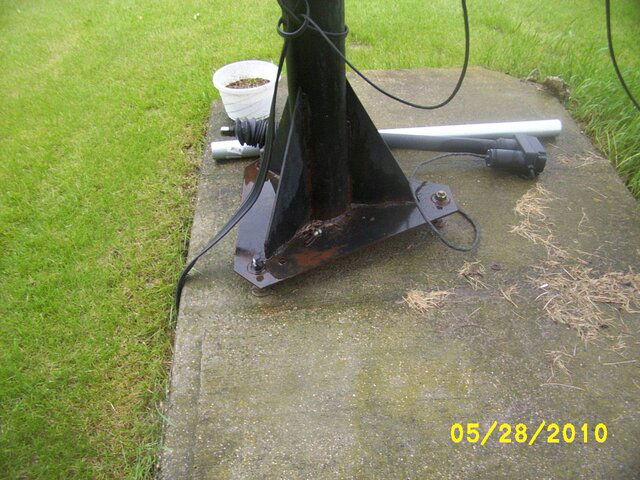
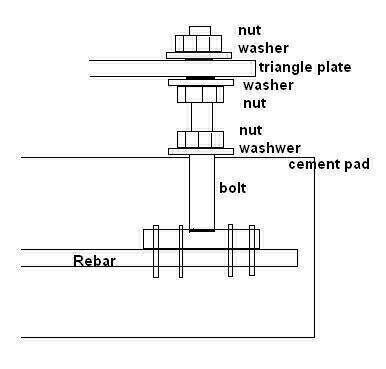
I like that set-up! will need to have someone weld that same type configuration to the bottom of my pole, but do like the "floating slab" idea.Do you have a welder or know someone with one. If so you could pour a concrete slab deep enough to be below the frost line and add whatever metal is needed to your pole to mount it like this, which allows for easy plumbing of the pole as well as future adjustment should anything shift. (Photos are courtesy of Fat Air from some tips he gave me in another thread):
View attachment 104903 View attachment 104904
Thanks, when it purchased it was made by a company called Precision Antennas here in the UK, now they're Elite Antennas but the process is still the same with all the reflectors being hand spun. I've since replaced mine with a 1.8m version shown in the photo, all their models up to 2.2m are single sheet aluminium and even the 3.7m is just two sheets welded together then hand spun. They are great performers and very well built. There's a video on this page showing the spinning process. http://www.elite-antennas.com/reflector-spinning
Attachments
- Status
- Please reply by conversation.
Similar threads
- Replies
- 5
- Views
- 1K
- Replies
- 16
- Views
- 1K
- Replies
- 14
- Views
- 3K
- Replies
- 5
- Views
- 2K
- Replies
- 17
- Views
- 4K


